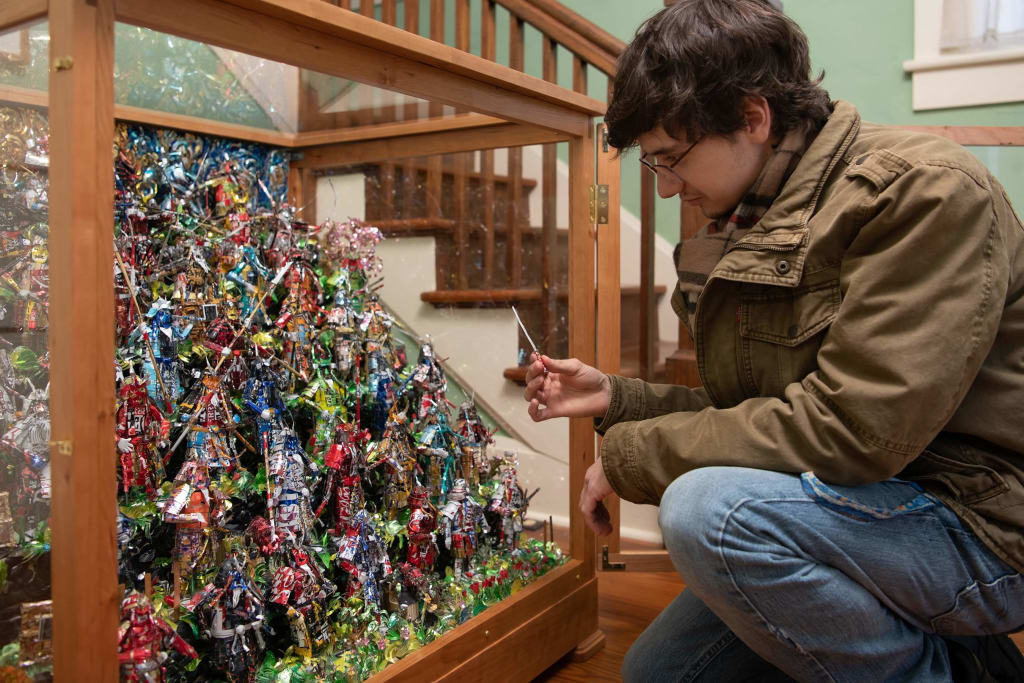
In early 2018 I had an idea. To construct a large, commemorative sculpture depicting the 47 Rōnin. The catch, however, was that I wanted to make entirely it out of disassembled, chopped and butchered, bent and tied…soda cans. In October of that same year, after more than 800 hours and 36,000 carefully tied pieces later, I finally finished the work. The journey to create such a thing, however, is much more complex and storied than that. Here goes nothing.
You never know when you’re going to just, simply and immediately, fall in love with an idea. That happened to me after a dive into Japanese cinema. I watched the works of Akira Kurosawa and Kenji Mizoguchi, the latter of which directed The 47 Rōnin in 1941. It was while watching that film that I fell in love with the story of the 47 Rōnin, the motifs of honor and loyalty and the aesthetics of the culture itself. I researched the story, reading through history books and studying both historical and contemporary retellings in the forms of plays in the genres of bunraku and kabuki.
Soon enough, I was obsessed, having never before found a historical event so captivating and, in a sense, beautiful. I wanted to convey what the story meant to me, to share a bit of my enthusiasm and love in my own contemporary and unique way. I had previously sculpted with soda cans, but nothing on any grand scale. I knew, however, that the vibrant colors and metallic nature would be perfect for the Rōnin assembly.
I knew I would need to focus on the project for an extensive amount of time, and due to this, it would be required for me to not be focused on anything but the project itself. For most of 2018 I worked seven days a week. I would work as a house painter in the morning before going in as a line cook in the evenings while simultaneously pulling shifts at a coffee shop, and doing construction and landscaping on the side. By October of 2018, I was still painting houses in the morning and working at a pub in the evening. The latter of which proved useful for the project.
I could gather the cans for free, as the pub was situated between fraternity houses and their grounds would be littered with empty beer cans several days a week. After work I’d just make my rounds, picking them up off of the well-manicured lawns and thoroughly cleaned them. Over time, I amassed over 1,200 cans this way while a few coworkers were kind enough to make donations of already cleaned, vibrant cans. It would take several months to procure enough cans for the project, but once my entire room was filled from floor to ceiling with color-coordinate stacks of metallic madness, I was ready to commence.
Still a few months away from being able to take a few months off from work, I started drawing out a diagram for the basic construction, every piece was accounted for, every plate of armor and every string, every nose and hand and blade. I then began cutting the soda cans out into flat pieces using a gigantic pair of Fiskars Serrated scissors before cutting out individual pieces with smaller snips and electrician scissors. Essentially, at this point I’m cutting out squares for the armor plates and more complicated pieces to make the hands, masks, swords, and feet. Additionally, I used a paper cutter to slice long bits of “string” out of the cans to use for tying.
Once all the pieces were cut out, usually numbering between 330-700 pieces per figure, I would take a 1/16” drill and hand drill anywhere between 300-800 holes in the armor and underlying body architecture. After this, I started tying them together, securing some fixed parts with glue while the parts that required movement I left simply tied. I was pleased upon finishing the first of the Rōnin, a relatively simple sculpture consisting of 416 pieces of Dr. Pepper cans who had a slightly awkward posture and very rudimentary armor.
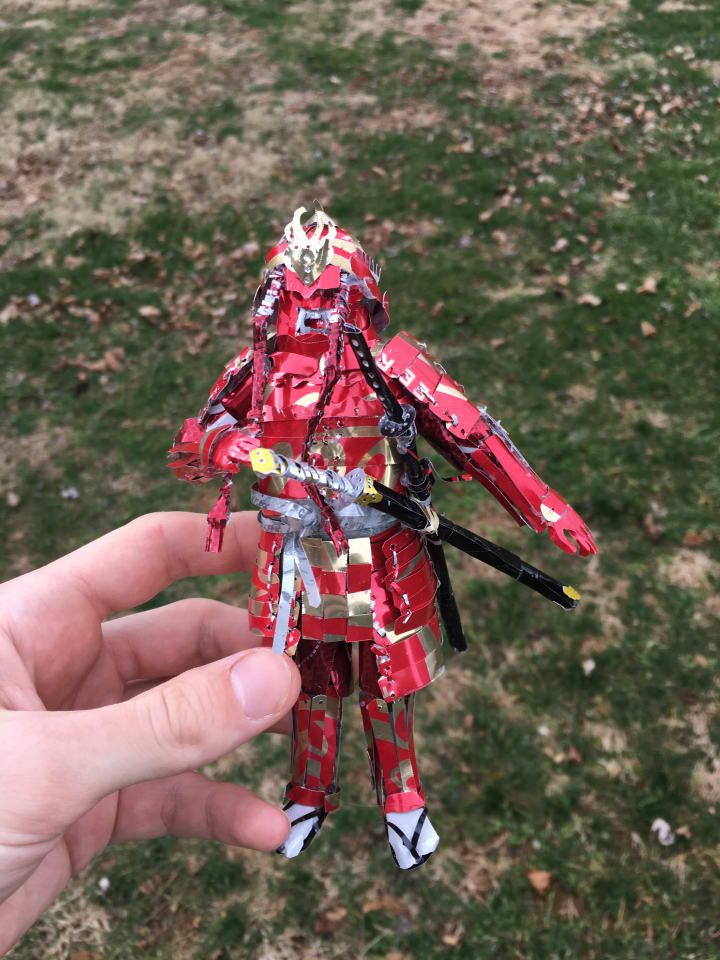
In the midst of assembling the samurai, I started building the display. I based it off of the traditional Hinamatsuri (Girl’s Day) displays of royal courts, feeling that if anyone was deserving of such status it would be the heroes of lore. The stand is roughly 3’ cubed, with seven steps made out of scrap poplar. I would make the half hour drive out of town to my dad’s old woodshop in between jobs to work on the frame, which took 40-50 hours by itself due to my relative inexperience. After a month or so, however, the tiered base was complete.
By March of that year I had finally accrued enough income from my jobs to take a few months off, working out just in time at the pub as the students were all leaving town and our hours would be cut down to practically nothing regardless. It was then that I was finally able to focus, spending fifteen hours a day, seven days a week, piecing together the Rōnin. I worked like an assembly line, cutting out every piece that I had by then memorized before drilling and tying them together into unique, complicated creations.
Each of the warriors took 6-24 hours to make, and each was constructed with a similar base but different colors and different patterns in the armor and different engravings on the sword based on traditional Japanese imagery and poetry. On the seven tiers of the Hinamatsuri display, I placed six rows of seven, placing the Rōnin chronologically in the order that I’d made them before finally finding myself, by then in mid-July, on the final row.
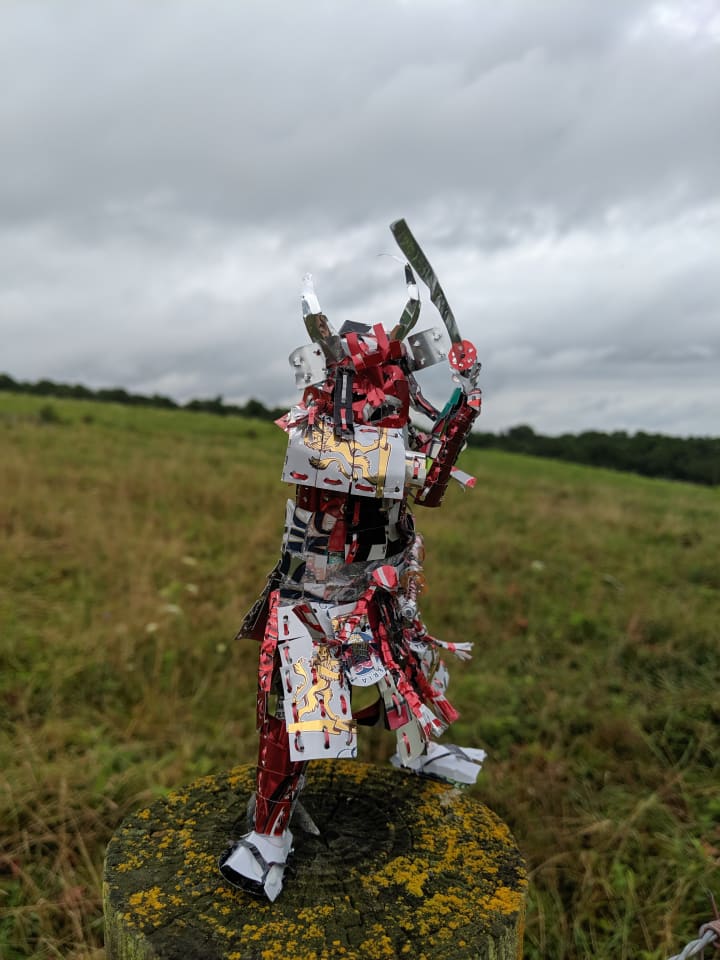
The creation of Oishi Yoshio and the Four
The final row consisted of the leader of the Rōnin, Oishi Yoshio, and four other Rōnin along with a blossoming cherry tree. The four Rōnin were more intricate than any of the others previously constructed, taking one to two full days of work each to create, and consisting of 500-700 individual pieces that were intricately cut, folded, and engraved. Their weapons, too, were more intricate and thorough than all that had come before them. In a week, however, I had finished the four, having worked from eight in the morning to often beyond midnight.
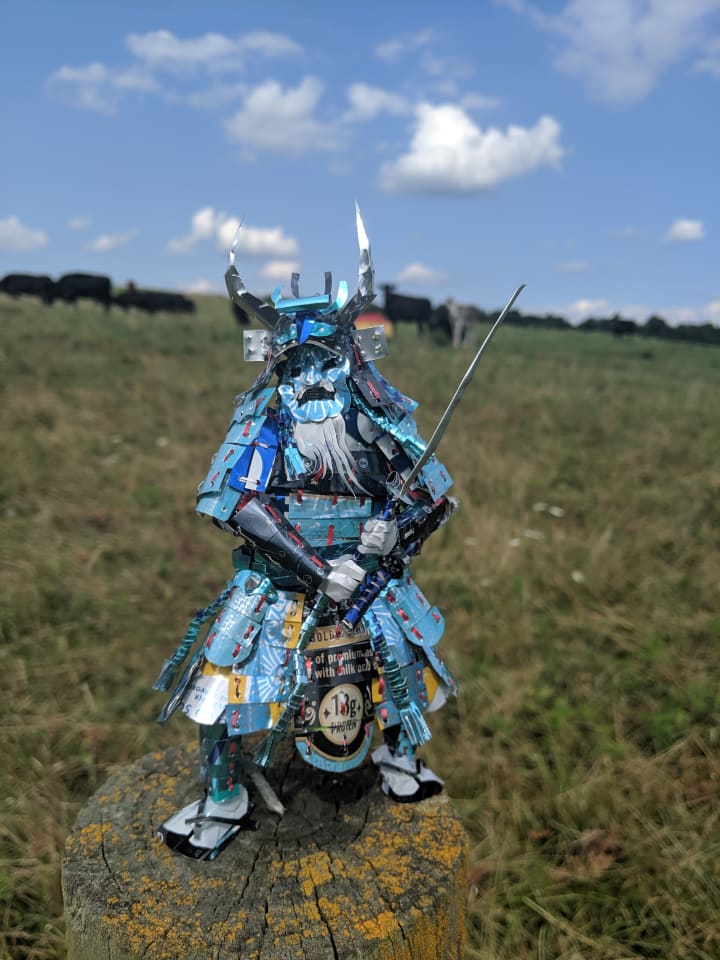
The four consists of four themes in their color and design curated to represent the natural world. They are as follows, from left to right, with Oishi to occupy the center.
Black and gold: Represents the dark nights, the long, solemn wait for the Rōnin to seek their revenge while the gold represents the sun of their victory.
White and Red: The white represents the purity of their mission, and the red commemorates their sacrifice upon committing seppuku following their act. The armor also features lions, while not necessarily accurate for Japanese imagery at the time, the lions represent strength and royalty.
Blue: Representing the sky and oceans, the greatest and most powerful things in the natural world, the source of storms and life itself.
Green, orange, and red: Representing the changes of seasons the Rōnin had to endure before exacting their plan for revenge.
At last, I was alone with only one Rōnin to finish, the leader, Oishi Yoshio. I took a higher level of care with his construction, making his entire armor out of plain black and red cans. Using the blank surfaces, I etched each of the 47 Rōnin’s names into the plates in Japanese after researching the translations at a university library. Following the armor, I crafted his two swords over several hours each, etching a haiku from into both along with the head of a folklore demon.
Unlike all the other Rōnin, the leader I sculpted with his helmet off, piecing together tufts of hair, ears, a nose, and even the pupils of his eyes out of soda cans before tying it all together in a tight knot. Completed, I placed him at the top of the display, centralized at the apex and staring down the tiers over his men.
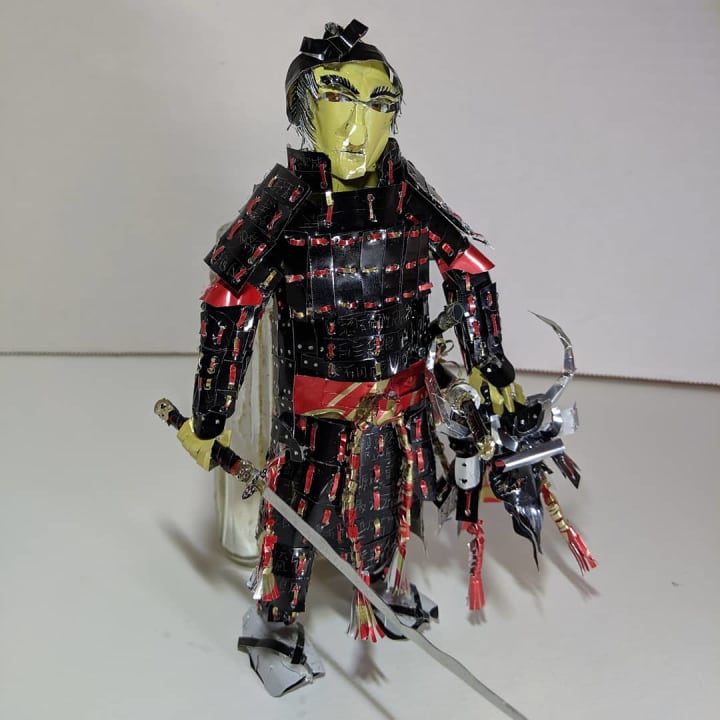
After completing the Rōnin themselves, I had to sculpt filler for the display itself. Still using nothing but soda cans, I created over a thousand flowers that were separated by small rocks and tufts of grass. To break up the monotony, I also created another cherry tree with over 200 blossoms. On the tiers I added sections of traditionally-inspired “bamboo” fencing, and on the open sections carefully engraved emulations of old wood prints onto soda can and tied it onto the surface. Lastly, I used old brass plaques, the only non-soda can material in the sculpture, to engrave as 47 tombstones for the Rōnin.
At last, the tiers of the display were complete, but I still had two completely blank vertical sides holding up the display itself. On one side, I crafted a peach orchard with distant mountains. On the other, I pieced together, very slowly, a field of several thousand chrysanthemums. Both sides blend into the top of each step in the display.
With the display completed, it needed to be protected and encased. I used a locally-sourced cherry, piecing together a simple case that used acrylic glass to protect the 47 figurines. The display itself weighs over one hundred pounds in its entirety, and was finished in late October of 2019.
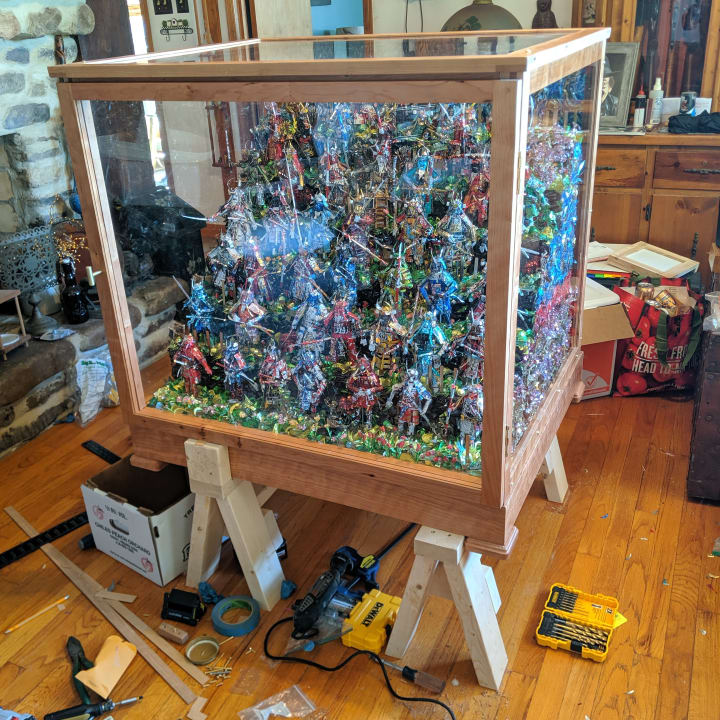
I’ve done dozens of sculptures since completing the 47 Rōnin, but have never felt the same emotional connection as I did with it. It stands as my opus, having never had the sudden, intense passion for a idea strike me since. I learned from it, not just as an artist working in a medium that few others ever bothered to try, but as a person. Through crafting the display and the Rōnin themselves, researching their story and its many interpretations, I learned the lessons most cherished in the story itself.
I learned to be patient, to work tirelessly at a multitude of jobs at once for year to give myself time to create the 47 Rōnin uninterrupted. I learned loyalty, what it meant to have absolute faith in something, even if it was my own project. I learned to wake up in the morning thinking about something, only to fall asleep thinking of the same thing. I learned honor, knowing that any shortcuts I took or laziness in the manufacturing would result in a defect or blemish that I, knowing the significance of the event itself, couldn’t accept.
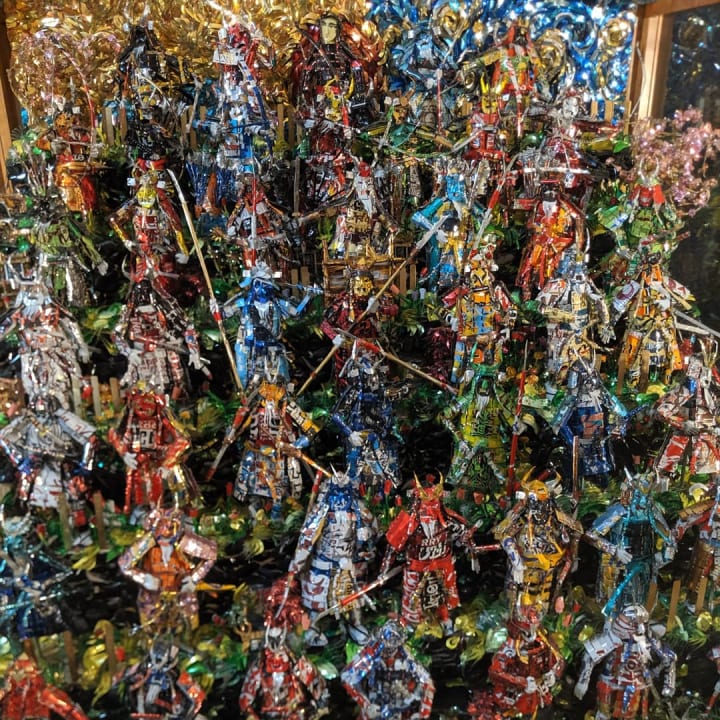
Over the course of nearly two years, what at first was a simple idea became a fascination, and that fascination became a love and adoration for Japanese culture and history. That love, of course, manifested in a single creation, a labor of blood, sweat, and tears. That love became The 47 Rōnin.
About the Creator
Shlunka
Visual artist and writer working out of a small Virginia town in the Shenandoah Valley.






Comments
There are no comments for this story
Be the first to respond and start the conversation.